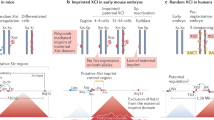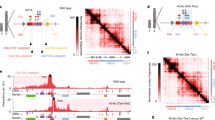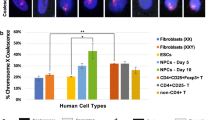Abstract
X-CHROMOSOME inactivation results in the strictly cis-limited inactivation of many but not all genes on one of the two X chromosomes during early development in somatic cells of mammalian females1. One feature of virtually all models of X inactivation is the existence of an X-inactivation centre (XIC) required in cis for inactivation to occur2–5. This concept predicts that all structurally abnormal X chromosomes capable of being inactivated have in common a defineable region of the X chromosome6–8. Here we report an analysis of several such rearranged human X chromosomes and define a minimal region of overlap. The results are consistent with models invoking a single XIC and provide a molecular foothold for cloning and analysing theXIC region. One of the markers that defines this region is theXIST gene9, which is expressed specifically from inactive, but not active, X chromosomes. The localization of the XIST gene to theXIC region on the human X chromosome implicates XIST in some aspect of X inactivation.
This is a preview of subscription content, access via your institution
Access options
Subscribe to this journal
Receive 51 print issues and online access
$199.00 per year
only $3.90 per issue
Buy this article
- Purchase on Springer Link
- Instant access to full article PDF
Prices may be subject to local taxes which are calculated during checkout
Similar content being viewed by others
References
Lyon, M. F. Nature 190, 372–373 (1961).
Lyon, M. F. Nature new Biol. 232, 229–232 (1971).
Russell, L. B. Science 140, 976–978 (1963).
Gartler, S. M. & Riggs, A. D. A. Rev. Genet. 17, 155–190 (1983).
Cattanach, B. M. A. Rev. Genet. 9, 1–18 (1975).
Mattei, M. G., Mattei, J. F., Vidal, I. & Giraud, F. Hum. Genet. 56, 401–408 (1981).
Summitt, R. L., Tipton, R. E., Wilroy, R. S. Jr, Martens, P. & Phelan, J. P. Birth Defects: Orig. Art. Ser. 14, 219–247 (1978).
Therman, E., Sarto, G. E. & Patau, K. Chromosoma 44, 361–366 (1974).
Brown, C. J. et al. Nature 349, 38–44 (1991).
Buhler, E. M., Jurik, L. P., Voyame, M. & Buhler, U. K. Nature 265, 142–144 (1977).
Morishima, A., Grumback, M. M. & Taylor, J. H. Proc. natn. Acad. Sci. U.S.A. 48, 756–763 (1962).
Latt, S. A. Expl Cell Res. 86, 412–415 (1974).
Allderdice, P. W., Miller, O. J., Miller, D. W. & Klinger, H. P. Am. J. med. Genet. 2, 233–240 (1978).
Tantravahi, U. et al. Hum. Genet. 64, 33–38 (1983).
Pettigrew, A. L., McCabe, E. R. B., Elder, F. F. B. & Ledbetter, D. H. Am. J. hum. Genet. 43, A118 (1988).
Mandel, J. L. et al. Cytogenet. Cell Genet. 51, 384–437 (1989).
Mahtani, M. M. & Willard, H. F. Genomics 2, 294–301 (1988).
Brown, C. J., Powers, V. E., Monroe, D. M., Sheinin, R. & Willard, H. F. Somat. Cell molec Genet. 15, 93–96 (1989).
Brown, C. J. et al. Am. J. hum. Genet. 44, 264–269 (1989).
Keer, J. T. et al. Genomics 7, 566–572 (1990).
Johnston, P. G. & Cattanach, B. M. Genet. Res. 37, 151–160 (1981).
Brown, C. J., Fienniken, A., Williams, B. & Willard, H. F. Nucleic Acids Res. 18, 4191–4195 (1990).
Wang, T. et al. Proc. natn. Acad Sci. U.S.A. 82, 5270–5274 (1985).
Brown, S. W. & Chandra, H. S. Proc. natn. Acad. Sci. U.S.A. 70, 195–199 (1973).
Rastan, S. J. Embryol. exp. Morph. 78, 1–22 (1983).
Schneider-Gadicke, A., Beer-Romero, P., Brown, L. G., Nussbaum, R. & Page, D. C. Cell 57, 1247–1258 (1989).
Brown, C. J. & Willard, H. F. Am. J. hum. Genet. 45, 273–279 (1990).
Mohandas, T. et al. Proc. natn. Acad. Sci. U.S.A. 84, 4954–4958 (1987).
Rastan, S. & Robertson, E. J. J. Embryol. exp. Morph. 90, 379–388 (1985).
Lyon, M. F. et al. J. Embryol. exp. Morph. 97, 75–85 (1986).
Riggs, A. D. Aust. J. Zool. 37, 419–441 (1990).
Sharp, C. B., Bedford, H. M. & Willard, H. F. Hum. Genet. 85, 330–336 (1990).
Wong, S. W. et al. EMBO J. 7, 37–47 (1988).
Author information
Authors and Affiliations
Rights and permissions
About this article
Cite this article
Brown, C., Lafreniere, R., Powers, V. et al. Localization of the X inactivation centre on the human X chromosome in Xq13. Nature 349, 82–84 (1991). https://doi.org/10.1038/349082a0
Received:
Accepted:
Issue Date:
DOI: https://doi.org/10.1038/349082a0
Comments
By submitting a comment you agree to abide by our Terms and Community Guidelines. If you find something abusive or that does not comply with our terms or guidelines please flag it as inappropriate.



